Abstract
1. Diadenosine tetraphosphate (Ap4A) a dinucleotide stored and released from rat brain synaptic terminals presents two types of affinity binding sites in synaptosomes. When [3H]-Ap4A was used for binding studies a Kd value of 0.10 +/- 0.014 nM and a Bmax value of 16.6 +/- 1.2 fmol mg-1 protein were obtained for the high affinity binding site from the Scatchard analysis. The second binding site, obtained by displacement studies, showed a Ki value of 0.57 +/- 0.09 microM. 2. Displacement of [3H]-Ap4A by non-labelled Ap4A and P2-purinoceptor ligands showed a displacement order of Ap4A > adenosine 5'-O-(2-thiodiphosphate) (ADP-beta-S) > 5'-adenylyl-imidodiphosphate (AMP-PNP) > alpha,beta-methylene adenosine 5'-triphosphate (alpha,beta-MeATP) in both sites revealed by the Ki values of 0.017 nM, 0.030 nM, 0.058 nM and 0.147 nM respectively for the high affinity binding site and values of 0.57 microM, 0.87 microM, 2.20 microM and 4.28 microM respectively for the second binding site. 3. Studies of the P2-purinoceptors present in synaptosomes were also performed with [35S]-ADP-beta-S. This radioligand showed two binding sites the first with Kd and Bmax values of 0.11 +/- 0.022 nM and 3.9 +/- 2.1 fmol mg-1 of protein respectively for the high affinity binding site obtained from the Scatchard plot. The second binding site showed a Ki of 0.018 +/- 0.0035 microM obtained from displacement curves. 4. Competition studies with diadenosine polyphosphates of [35S]-ADP-beta-S binding showed a displacement order of Ap4A > Ap5A > Ap6A in the high affinity binding site and Ki values of 0.023 nM, 0.081 nM and 5.72 nM respectively.(ABSTRACT TRUNCATED AT 250 WORDS)
Full text
PDF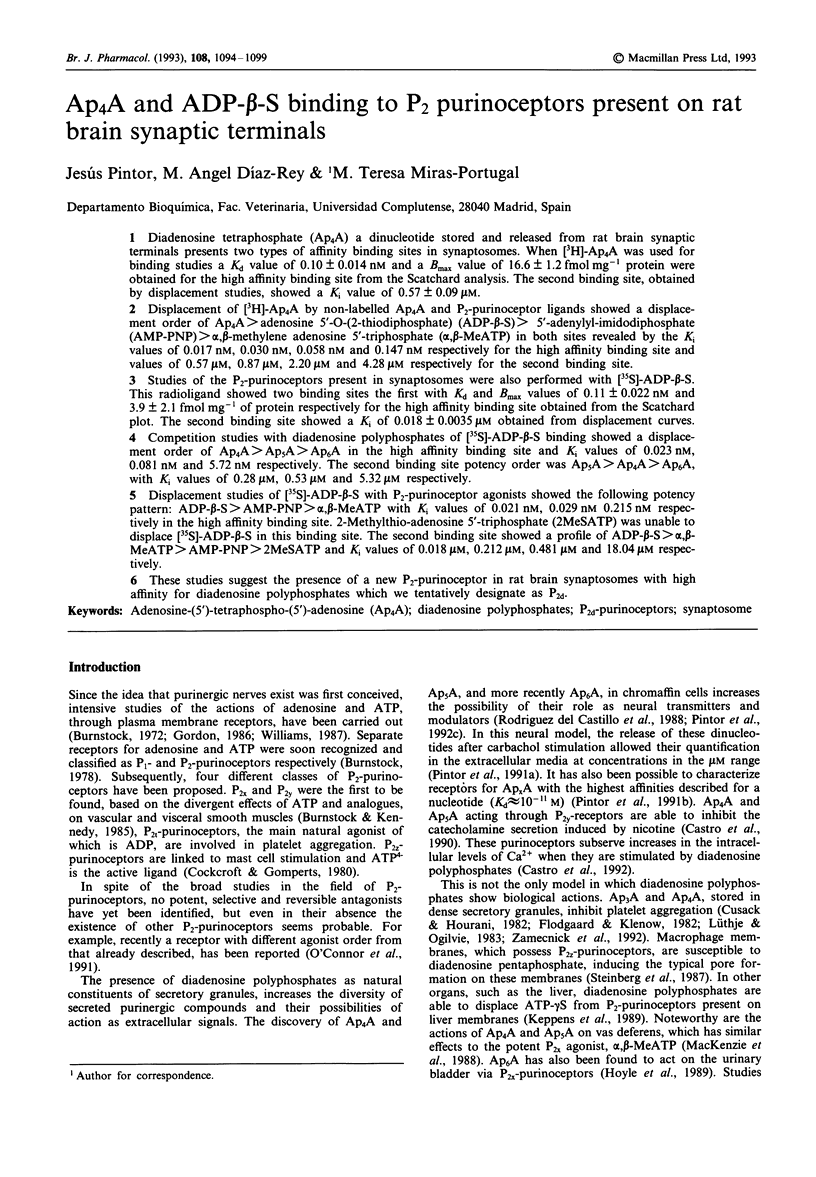
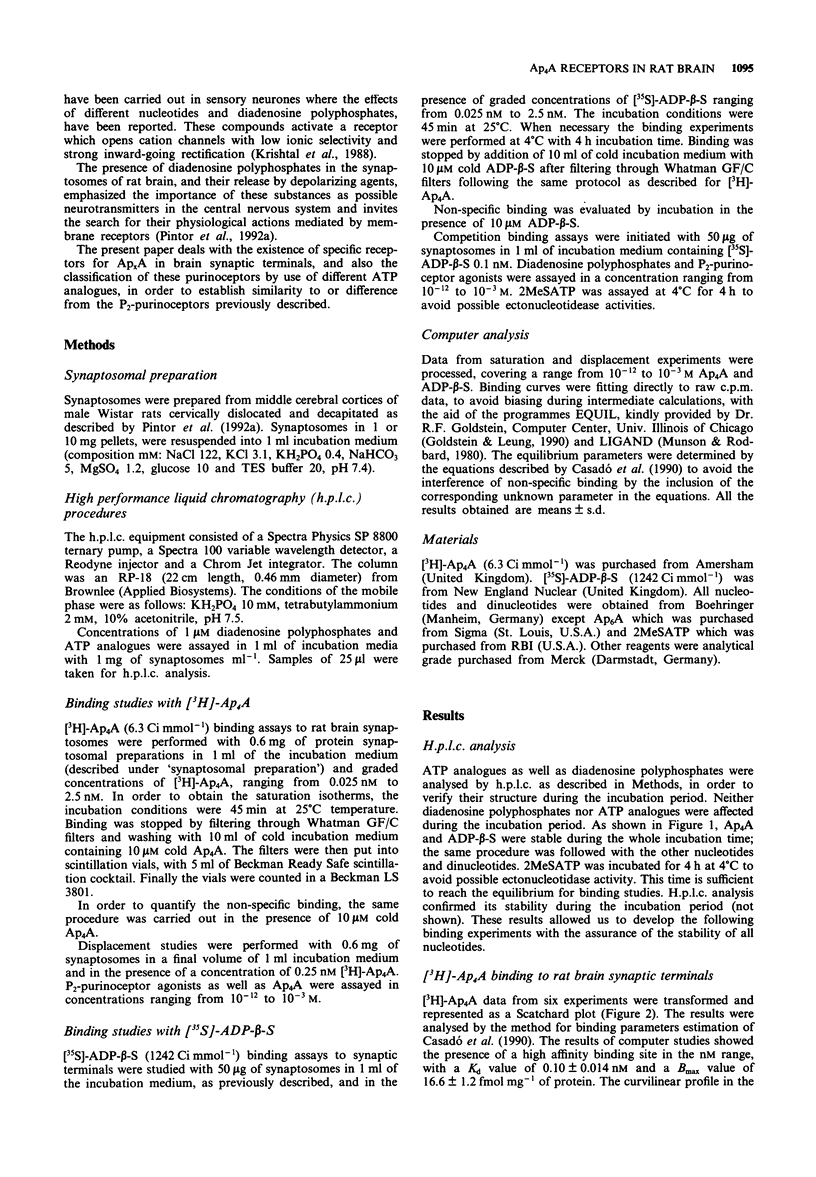
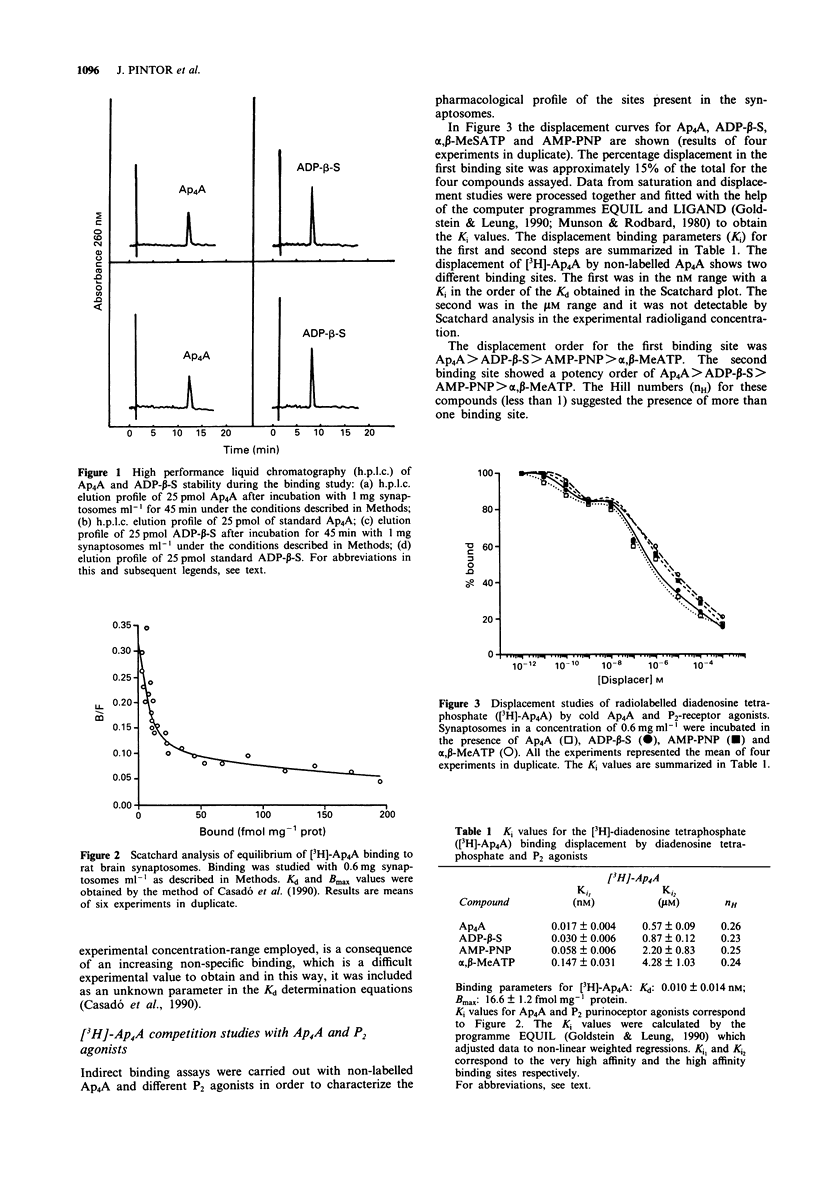
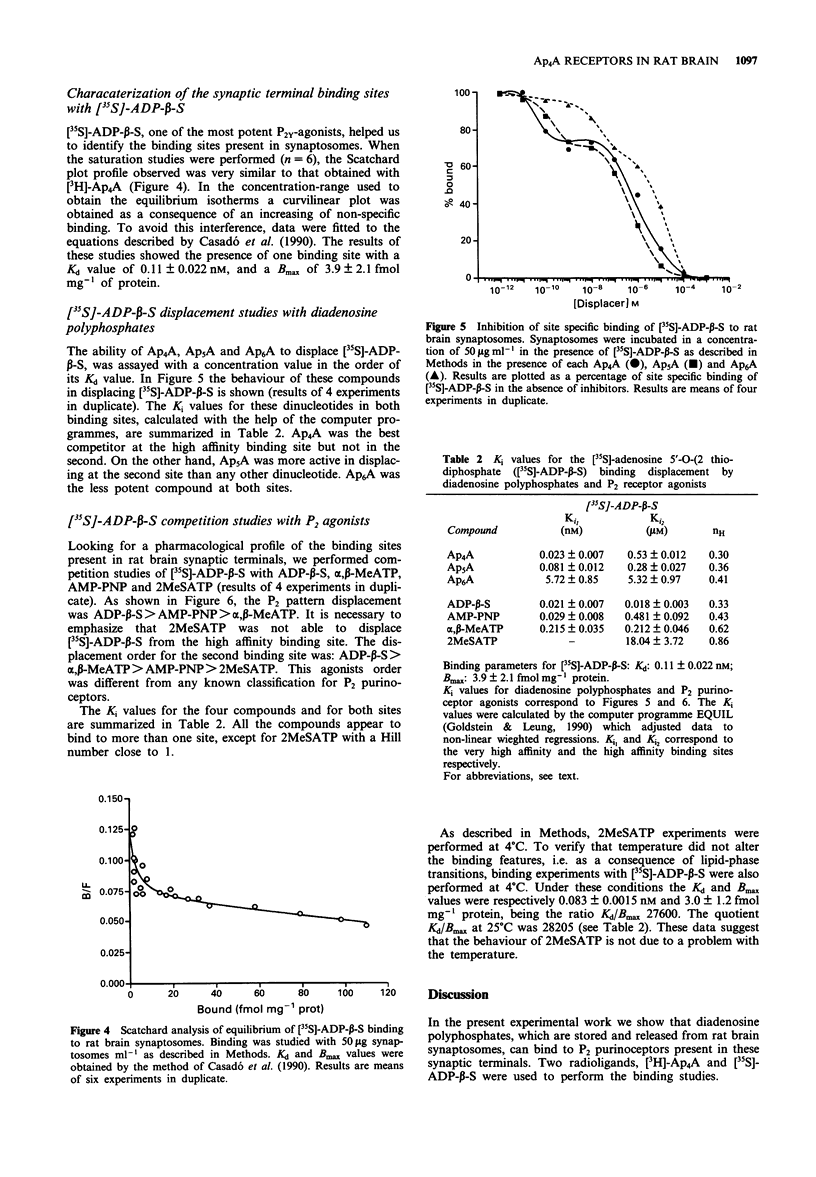
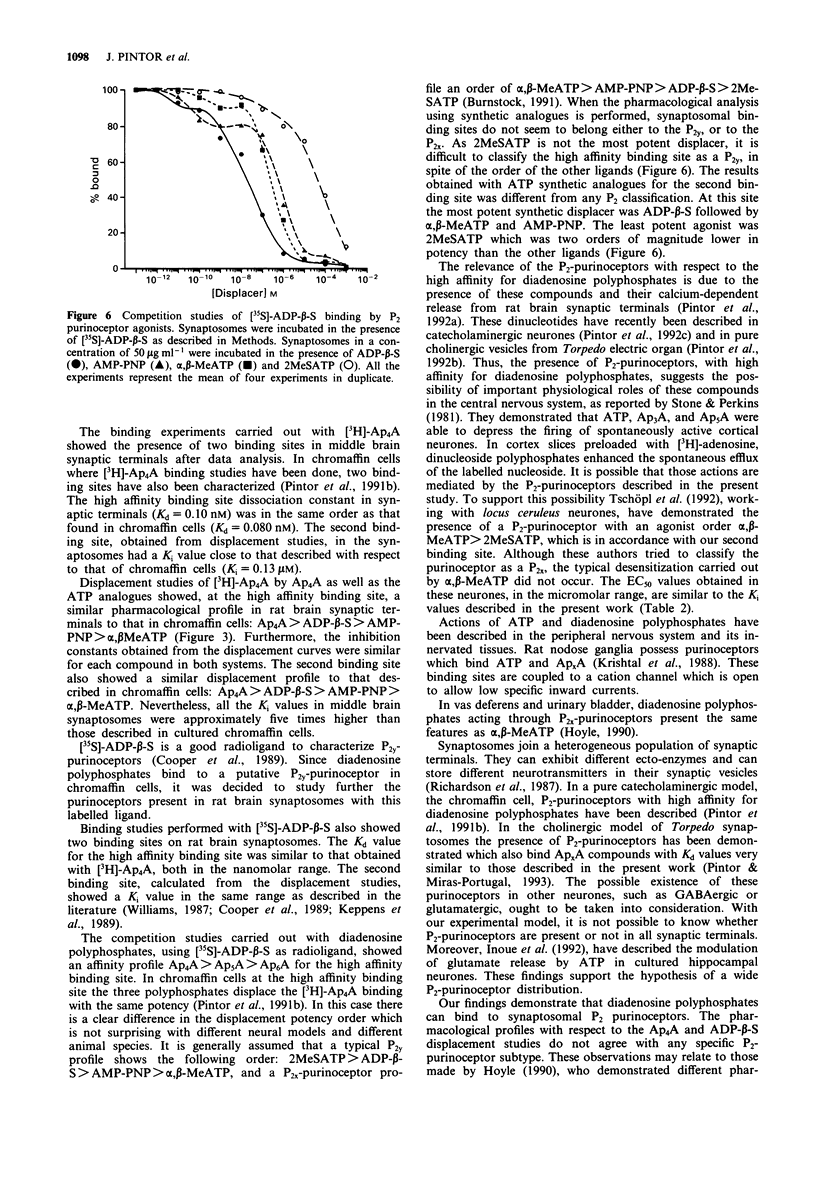
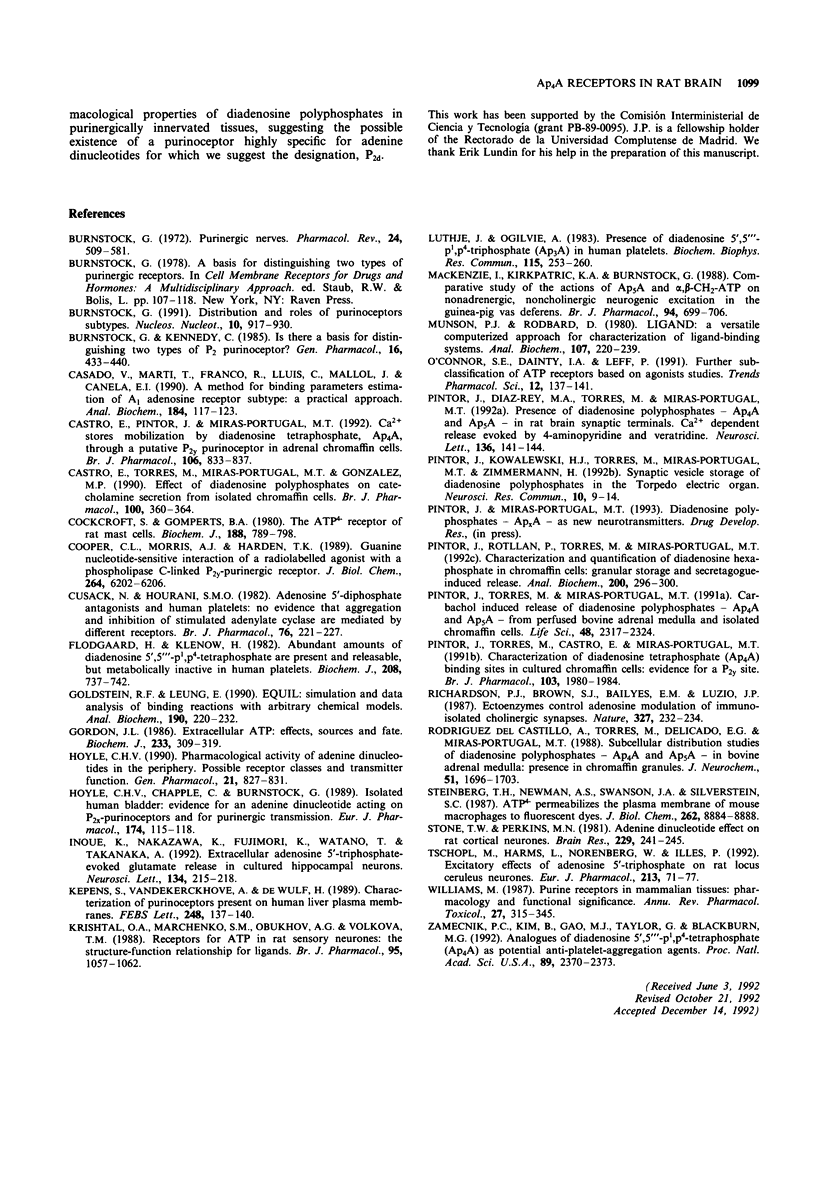
Selected References
These references are in PubMed. This may not be the complete list of references from this article.
- Burnstock G., Kennedy C. Is there a basis for distinguishing two types of P2-purinoceptor? Gen Pharmacol. 1985;16(5):433–440. doi: 10.1016/0306-3623(85)90001-1. [DOI] [PubMed] [Google Scholar]
- Burnstock G. Purinergic nerves. Pharmacol Rev. 1972 Sep;24(3):509–581. [PubMed] [Google Scholar]
- Casadó V., Martí T., Franco R., Lluis C., Mallol J., Canela E. I. A method for binding parameters estimation of A1 adenosine receptor subtype: a practical approach. Anal Biochem. 1990 Jan;184(1):117–123. doi: 10.1016/0003-2697(90)90022-2. [DOI] [PubMed] [Google Scholar]
- Castro E., Pintor J., Miras-Portugal M. T. Ca(2+)-stores mobilization by diadenosine tetraphosphate, Ap4A, through a putative P2Y purinoceptor in adrenal chromaffin cells. Br J Pharmacol. 1992 Aug;106(4):833–837. doi: 10.1111/j.1476-5381.1992.tb14421.x. [DOI] [PMC free article] [PubMed] [Google Scholar]
- Castro E., Torres M., Miras-Portugal M. T., Gonzalez M. P. Effect of diadenosine polyphosphates on catecholamine secretion from isolated chromaffin cells. Br J Pharmacol. 1990 Jun;100(2):360–364. doi: 10.1111/j.1476-5381.1990.tb15809.x. [DOI] [PMC free article] [PubMed] [Google Scholar]
- Cockcroft S., Gomperts B. D. The ATP4- receptor of rat mast cells. Biochem J. 1980 Jun 15;188(3):789–798. doi: 10.1042/bj1880789. [DOI] [PMC free article] [PubMed] [Google Scholar]
- Cooper C. L., Morris A. J., Harden T. K. Guanine nucleotide-sensitive interaction of a radiolabeled agonist with a phospholipase C-linked P2y-purinergic receptor. J Biol Chem. 1989 Apr 15;264(11):6202–6206. [PubMed] [Google Scholar]
- Cusack N. J., Hourani S. M. Adenosine 5-diphosphate antagonists and human platelets: no evidence that aggregation and inhibition of stimulated adenylate cyclase are mediated by different receptors. Br J Pharmacol. 1982 May;76(1):221–227. doi: 10.1111/j.1476-5381.1982.tb09210.x. [DOI] [PMC free article] [PubMed] [Google Scholar]
- Flodgaard H., Klenow H. Abundant amounts of diadenosine 5',5"'-P1,P4-tetraphosphate are present and releasable, but metabolically inactive, in human platelets. Biochem J. 1982 Dec 15;208(3):737–742. doi: 10.1042/bj2080737. [DOI] [PMC free article] [PubMed] [Google Scholar]
- Goldstein R. F., Leung E. EQUIL: simulation and data analysis of binding reactions with arbitrary chemical models. Anal Biochem. 1990 Nov 1;190(2):220–232. doi: 10.1016/0003-2697(90)90184-b. [DOI] [PubMed] [Google Scholar]
- Gordon J. L. Extracellular ATP: effects, sources and fate. Biochem J. 1986 Jan 15;233(2):309–319. doi: 10.1042/bj2330309. [DOI] [PMC free article] [PubMed] [Google Scholar]
- Hoyle C. H., Chapple C., Burnstock G. Isolated human bladder: evidence for an adenine dinucleotide acting on P2X-purinoceptors and for purinergic transmission. Eur J Pharmacol. 1989 Dec 12;174(1):115–118. doi: 10.1016/0014-2999(89)90881-9. [DOI] [PubMed] [Google Scholar]
- Hoyle C. H. Pharmacological activity of adenine dinucleotides in the periphery: possible receptor classes and transmitter function. Gen Pharmacol. 1990;21(6):827–831. doi: 10.1016/0306-3623(90)90440-w. [DOI] [PubMed] [Google Scholar]
- Inoue K., Nakazawa K., Fujimori K., Watano T., Takanaka A. Extracellular adenosine 5'-triphosphate-evoked glutamate release in cultured hippocampal neurons. Neurosci Lett. 1992 Jan 6;134(2):215–218. doi: 10.1016/0304-3940(92)90520-h. [DOI] [PubMed] [Google Scholar]
- Keppens S., Vandekerckhove A., De Wulf H. Characterization of purinoceptors present on human liver plasma membranes. FEBS Lett. 1989 May 8;248(1-2):137–140. doi: 10.1016/0014-5793(89)80448-x. [DOI] [PubMed] [Google Scholar]
- Krishtal O. A., Marchenko S. M., Obukhov A. G., Volkova T. M. Receptors for ATP in rat sensory neurones: the structure-function relationship for ligands. Br J Pharmacol. 1988 Dec;95(4):1057–1062. doi: 10.1111/j.1476-5381.1988.tb11739.x. [DOI] [PMC free article] [PubMed] [Google Scholar]
- Lüthje J., Ogilvie A. The presence of diadenosine 5',5'''-P1,P3-triphosphate (Ap3A) in human platelets. Biochem Biophys Res Commun. 1983 Aug 30;115(1):253–260. doi: 10.1016/0006-291x(83)90997-x. [DOI] [PubMed] [Google Scholar]
- MacKenzie I., Kirkpatrick K. A., Burnstock G. Comparative study of the actions of AP5A and alpha,beta-methylene ATP on nonadrenergic, noncholinergic neurogenic excitation in the guinea-pig vas deferens. Br J Pharmacol. 1988 Jul;94(3):699–706. doi: 10.1111/j.1476-5381.1988.tb11578.x. [DOI] [PMC free article] [PubMed] [Google Scholar]
- Munson P. J., Rodbard D. Ligand: a versatile computerized approach for characterization of ligand-binding systems. Anal Biochem. 1980 Sep 1;107(1):220–239. doi: 10.1016/0003-2697(80)90515-1. [DOI] [PubMed] [Google Scholar]
- O'Connor S. E., Dainty I. A., Leff P. Further subclassification of ATP receptors based on agonist studies. Trends Pharmacol Sci. 1991 Apr;12(4):137–141. doi: 10.1016/0165-6147(91)90530-6. [DOI] [PubMed] [Google Scholar]
- Pintor J., Díaz-Rey M. A., Torres M., Miras-Portugal M. T. Presence of diadenosine polyphosphates--Ap4A and Ap5A--in rat brain synaptic terminals. Ca2+ dependent release evoked by 4-aminopyridine and veratridine. Neurosci Lett. 1992 Mar 2;136(2):141–144. doi: 10.1016/0304-3940(92)90034-5. [DOI] [PubMed] [Google Scholar]
- Pintor J., Rotllán P., Torres M., Miras-Portugal M. T. Characterization and quantification of diadenosine hexaphosphate in chromaffin cells: granular storage and secretagogue-induced release. Anal Biochem. 1992 Feb 1;200(2):296–300. doi: 10.1016/0003-2697(92)90469-n. [DOI] [PubMed] [Google Scholar]
- Pintor J., Torres M., Castro E., Miras-Portugal M. T. Characterization of diadenosine tetraphosphate (Ap4A) binding sites in cultured chromaffin cells: evidence for a P2y site. Br J Pharmacol. 1991 Aug;103(4):1980–1984. doi: 10.1111/j.1476-5381.1991.tb12363.x. [DOI] [PMC free article] [PubMed] [Google Scholar]
- Pintor J., Torres M., Miras-Portugal M. T. Carbachol induced release of diadenosine polyphosphates--Ap4A and Ap5A--from perfused bovine adrenal medulla and isolated chromaffin cells. Life Sci. 1991;48(24):2317–2324. doi: 10.1016/0024-3205(91)90268-g. [DOI] [PubMed] [Google Scholar]
- Richardson P. J., Brown S. J., Bailyes E. M., Luzio J. P. Ectoenzymes control adenosine modulation of immunoisolated cholinergic synapses. Nature. 1987 May 21;327(6119):232–234. doi: 10.1038/327232a0. [DOI] [PubMed] [Google Scholar]
- Rodriguez del Castillo A., Torres M., Delicado E. G., Miras-Portugal M. T. Subcellular distribution studies of diadenosine polyphosphates--Ap4A and Ap5A--in bovine adrenal medulla: presence in chromaffin granules. J Neurochem. 1988 Dec;51(6):1696–1703. doi: 10.1111/j.1471-4159.1988.tb01147.x. [DOI] [PubMed] [Google Scholar]
- Steinberg T. H., Newman A. S., Swanson J. A., Silverstein S. C. ATP4- permeabilizes the plasma membrane of mouse macrophages to fluorescent dyes. J Biol Chem. 1987 Jun 25;262(18):8884–8888. [PubMed] [Google Scholar]
- Stone T. W., Perkins M. N. Adenine dinucleotide effects on rat cortical neurones. Brain Res. 1981 Dec 14;229(1):241–245. doi: 10.1016/0006-8993(81)90764-2. [DOI] [PubMed] [Google Scholar]
- Tschöpl M., Harms L., Nörenberg W., Illes P. Excitatory effects of adenosine 5'-triphosphate on rat locus coeruleus neurones. Eur J Pharmacol. 1992 Mar 17;213(1):71–77. doi: 10.1016/0014-2999(92)90234-u. [DOI] [PubMed] [Google Scholar]
- Williams M. Purine receptors in mammalian tissues: pharmacology and functional significance. Annu Rev Pharmacol Toxicol. 1987;27:315–345. doi: 10.1146/annurev.pa.27.040187.001531. [DOI] [PubMed] [Google Scholar]
- Zamecnik P. C., Kim B., Gao M. J., Taylor G., Blackburn G. M. Analogues of diadenosine 5',5'''-P1,P4-tetraphosphate (Ap4A) as potential anti-platelet-aggregation agents. Proc Natl Acad Sci U S A. 1992 Mar 15;89(6):2370–2373. doi: 10.1073/pnas.89.6.2370. [DOI] [PMC free article] [PubMed] [Google Scholar]


